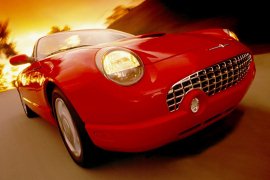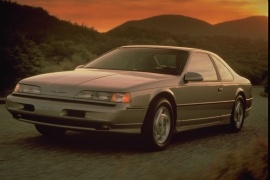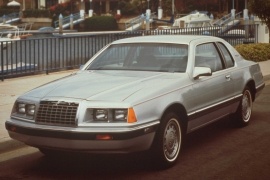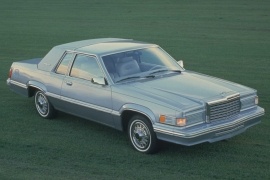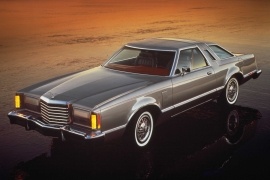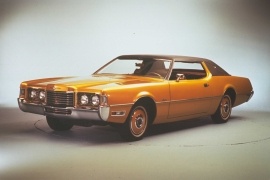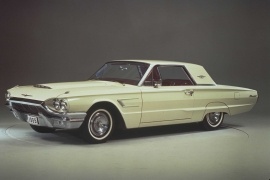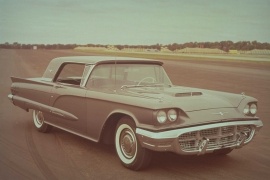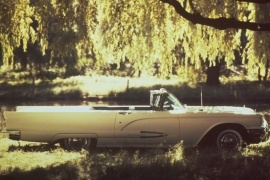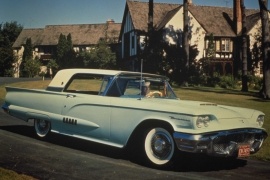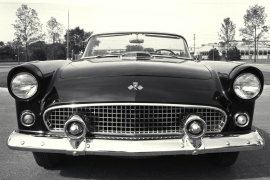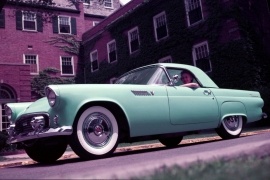FORD Thunderbird Models/Series Timeline, Specifications & Photos
First production year: 1955
Engines: Gasoline
Body style: Convertible (spider/spyder, cabrio/cabriolet, drop/open/soft top)
With its retro-design look and modern features, the 2001 Thunderbird should have been a blast from the past and revive the brand name, but it was a flop.
Ford launched the eleventh generation of the Thunderbird in 1999 as a 2001 model-year. It was based on the same platform as the Jaguar XF or the Lincoln LS. When it unveiled it, the whole market was enthusiastic, but that enthusiasm didn't last long, and the T-Bird sunk with slow sales. Its production ended in 2005.
The design was inspired by the first-generation of the T-Bird. The retro-design style could have been seen on the front fascia, with its big and round headlights and the flat, chromed grille with square-grid mesh. With a sloped silhouette, which started taller on the front fenders and descended toward the rear, the convertible inspired the old-style design theme, but in a modern interpretation. The hardtop featured an oval window on the C-pillar, resembling older Thunderbirds.
For the interior, Ford tried for several years to find the materials which would suit best for the car. In the end, it put just the same thing as in most of its other vehicles. A good thing was the new look for the instrument cluster, which featured four semi-circular dials, with red needles on white faces. But those didn't look too good next to the green LCD lettering placed on the bottom. Since the T-Bird was built as a personal luxury coupe, it featured two seats at the front and a bench in the back, all leather-wrapped.
Ford chose to fit one engine under the Thunderbird's hood: a 3.9-liter V8 taken from Jaguar. It was paired to a standard 5-speed automatic transmission. Later on, in 2003, T-Bird received an updated version, which provided 284 hp.
Designed to compete against the finest luxury German coupes on the market, the 1989 Ford Thunderbird was an underrated vehicle.
After the car was born, there were huge controversies in the Ford Motor Company, which led to the retirement of Anthony Kuchta, the man behind the project. The car exceeded its target price and its weight. All of a sudden, the T-Bird was the black sheep of the family who didn't get the much-needed lunch-money (advertising), and it didn't get the sales it deserved.
Just by looking at it, it was considered a good competitor for the BMW 6-series. It was a true, 4-seat coupe. On the hood, it featured the Thunderbird badge and a pair of slim, horizontal headlights. A grille on the lower side of the bumper plus two air-intakes right under the hood kept the engine cool. Unusual for those times, its rear wheels were placed behind the C-pillar and made the car look more advanced than its competitors.
Perhaps it was the interior that spoiled the car. The high, adjustable bolsters on the sport seats didn't look that good. At least, the center stack was right, with a logical layout for the stereo and the air-conditioning unit. In the back, there was room enough for two adult passengers. But the bland design was under the exterior's look.
Ford offered the Thunderbird with a choice of V6 and V8 engines. The V6 supercharged, also known as the SC, was one of the best from its series. It was available with a 5-speed manual from Mazda and could keep-up with the most important German sport luxury coupes. Unlike most of its American competitors, it featured an independent rear suspension, which added comfort for the big vehicle.
Ford built the ninth generation of the Thunderbird on the same Fox-body platform used for the Mercury Cougar, Ford LTD or Lincoln Continental.
Ever since the beginning of the Thunderbird, Ford worried about overlapping it with the Mustang, and while the pony-car received more powerful engines, the T-Bird got more features making it a personal luxury coupe. Unfortunately, since it didn't want to compete against the Mustang, Ford made the Thunderbird too slow and, despite its sleek design, it didn't make it into the top sales charts.
The exterior was way more improved than its predecessor. Its cab-rearward design with a long hood and a short trunk made it look very dynamic. Thanks to its raked windshield and sloped rear windscreen, it was quite attractive. At the front, the big horizontal headlights improved the car's look. Ford designers installed color-body wrapped-around bumpers both front and rear, with a rubber strip on them. From its sides, the small windows behind the doors brought more light inside the cabin.
Inside, the front bucket seats were designed for comfort. Since it was a personal-luxury vehicle, Ford installed wood-trims on the dash panel, doors and center console. On the center stack, the Thunderbird sported an auto-reverse stereo-cassette player placed lower than the air-conditioning control unit.
Under the hood, the best engine choice was a 2.3-liter turbocharged-four that provided more power than the 3.8-liter V-6 or the 5.0-liter V-8 engines. While the V-units were paired as standard to a sluggish 3-speed automatic transmission, the turbocharged unit was mated to a 5-speed manual.
Ford introduced the eighth generation of the Thunderbird for the 1980 model year, and while it was still a personal luxury coupe, it was far from the glorious model of the '60s.
During the late '70s, the CAFE agreement forced car manufacturers to produce more fuel-efficient vehicles, and Ford decided to shrink the Thunderbird. Furthermore, that scale-down process didn't just affect the vehicle's length, which was smaller by 10% than its predecessor, but the engine lineup as well. The eighth generation of this nameplate was the first to sport a six-cylinder engine. These modifications drastically affected sales, and Ford could barely sell more than 280,000 units of it between 1980 and 1982, while its predecessor reached that number in its worst year, 1979. The eighth generation of the Thunderbird relied on a stretched version of the Fox platform used by the Mercury Cougar.
The car's front abounded in wedged shapes, with a massive grille in the middle that resembled the T-Bird's seventh generation. Ford also installed retractable covers for the twin double headlights of the car. A set of parking lights and blinkers flanked them on the front fenders. The bumper was partly body-colored, part chromed, and looked upscale, trying to fit into the "luxury" part of the coupe designation. While the vehicle's overall shape did fit the design trends of those times, it wasn't something special like its predecessors.
For the eighth generation of the T-Bird, Ford tried to copy and use some of the design lines of the seventh generation of the vehicle, but it ended up resembling the Fairmont. As a result, the car featured opera windows (into the C-pillars, behind the doors). Its slightly flared wheel arches on both axles and the trims that adorned the doors made the car easy to recognize. In addition, at the back, the taillights followed the same pattern as usual for the Thunderbird, with taller outer lamps connected via a red stripe.
Inside, Ford tried to provide a more luxurious vehicle with high-tech features for that era, such as the LED speedometer and fuel gauge. The front seats featured bolstered areas, while the seats in the back were adequate for children due to limited legroom. Customers could order the car with a cruise control system that could be activated via buttons on the steering wheel, which was uncommon in 1980.
Ford made the Thunderbird to fit into the corporate average fuel efficiency (CAFE) agreement. The base engine for the coupe was a 4,2-liter V8, while a 5.0-liter powerplant was available. In addition, the automaker sold the car with a 3.3-liter inline-six or a 3.8-liter V6. By 1982, the 5.0-liter V8 was withdrawn from the market. All the power went to the rear wheels via a three- or four-speed automatic.
With the oil crisis over, car sales started to rise again, and Ford offered the Thunderbird as a personal luxury vehicle. And it was the most successful generation at that moment.
Back in the '70s, after the muscle-car era ended, Ford tried to keep the coupe vehicles on the market and attract wealthier people with the Thunderbird. The car was designed to offer comfort, not sportiness. But it could still keep up with some of the sportier cars of that moment thanks to its option for a 400 cu-in (6.6 liters) engine.
After the oil crisis and the CAFE agreement, most of the cars started to shrink, and the T-Bird followed the same downsizing trend. It was shorter than its predecessor, but it was still a big car that could compete with most of the 2000's luxury sedans, size-wise. At the front, it featured two round headlights covered with retractable lids and a pinned-out grille with horizontal slats. A specific badge with the Thunderbird silhouette replaced the blue-oval one from Ford. The raked B-pillar with a small glass area inside made the car looks sportier, and the carmaker offered a version with a targa-roof in T-top style.
Inside, the Thunderbird offered room for four adults with a split-bench in the front and a bench in the rear. Since it was designed as a comfortable ride, the carmaker installed individual plushy armrests for the front passengers. A broad and tall dashboard enhanced the luxurious appearance of the car.
Under the body, Ford used the same platform as for the Torino, LTD, or the sportier Mercury Cougar. Since it was 900 lbs (408 kg) lighter than its predecessor, it offered good performance, despite using smaller engines. A 3-speed automatic gearbox was fitted as standard for the entire range.
The seventh and largest Ford Thunderbird shook the American car industry in 1972 with its huge size and massive engines. But the 1973 oil crisis deeply cut into its sales.
In 1972 the Muscle-Car era was coming to an end, but nobody knew it. The only thing that stood between the big blocks and the customers was the emissions control regulations. But the carmakers were ready for that and fitted their cars with big engines tuned for shallow power for their engine's displacements. A 4.2-liter Jaguar engine provided 240 hp while the 7-liter T-Bird offered a mere 212 hp. Despite the higher torque, it was slower to the 60 mph mark (92 kph) than the British XJ limo.
Its double rounded headlights at the front and the pinned-out grille in the middle made the Thunderbird like a battleship on wheels. The long hood, suitable to cover one of the biggest V8 engines ever installed in a Ford, featured a profiled surface with a raised center part. From its sides, the car looked like a faux-cabriolet since it didn't feature a B-pillar between the doors and the quarter panel. Its overall length was so big that it should require its own zip-code. A red strip spread across the entire rear board in the rear, but only the outer sides were lit.
Inside, Ford offered the Thunderbird as a personal luxury coupe fitted with leather seats, automatic climate control, a mini AM-FM stereo (options), sunroof, and 6-way power front seats. Despite the car's size, the instrument cluster was compact, and, no wonder, the fuel gauge took center stage.
Ford installed a choice of two engines under the hood: a 7- and a 7.5-liter engine, both mated as standard to a 3-speed automatic gearbox.
It was the last year of manufacture for the fourth generation of the Thunderbird, but it was important for the novelties the car brought.
Back in '66, the Mustang got most of the attention of the market. But the Thunderbird was something different. It was built more like a luxury convertible than a sports car. It was more expensive than the original pony-car and offered more comfort than most cars on the market.
The '66 Thunderbird (or T-Bird) featured a metallic grille with vertical slats. Instead of the blue-oval badge, it featured a stylized bird. The headlights cluster mimicked an eagle's eye shape. A small central bulge enhanced the look of the, otherwise, flat surface on the flat hood. The quarter panels featured covers for the rear wheels, with a distinct chromed rim around the wheel-arch. As a luxury convertible, the Thunderbird was available with a power-roof that was hidden behind the cabin when retracted.
Ford designed the Thunderbird as a personal luxury coupe, inspired by the European luxury cars. Inside, it took inspiration from the "jet-era," with a tilted forward-center stack where it placed the controls for the stereo and the air-conditioning unit. The instrument cluster featured a linear speedometer and four, round, with aviation-inspired gauges for the oil-pressure, fuel-gauge, coolant temperature, and charging. The steering-column mounted gear-selector showed its position on a separate dial.
In 1966, Ford introduced a 6.4-liter engine that provided 320 hp paired as standard with a three-speed automatic transmission.
Fighting with its nimble brother Mustang proved to be more challenging for the Thunderbird, and Ford tried to improve the lineup to keep its customers.
Every now and then, a carmaker founds itself facing an intriguing problem with two vehicles from its own stable fighting against each other on the market. When Ford faced that dilemma with the Thunderbird and Mustang, it decided to adjust them for different market segments. The T-Bird was upgraded toward the personal-luxury coupe customers while the Mustang was the pony-car that made the teenagers happy.
The fourth generation of the Thunderbird might be the best-known from the nameplate's history, thanks not only to its seductive lines but also as starring in movies. While the model was introduced in 1964, it couldn't be changed too much, but the carmaker tried to make it more luxurious. Ford added a fake extracting vent behind the front wheels and a different air-intake on the hood, which was functional on the exterior.
Inside, the Thunderbird was available with power-seats, air-conditioning, power steering, and brakes, plus an AM radio in it. The speedometer was still with a colored ribbon that slid and filled a linear gauge. Thanks to its new luxury items, the Thunderbird became more attractive for customers in the personal-luxury segment, and Ford managed to sell over 200.000 units in less than three years. A special feature was the sliding steering column, which the driver could slide to the right to ease-up the ingress and egress from the car.
The fourth generation of the T-Bird evolved into a personal luxury coupe, and it stepped away from its previous sporty image. That credit went to the newly launched Mustang.
By the mid-'60s, the Thunderbird was already known and respected both on the streets and in car culture. It was the car that made Corvette looks foolish, and it did that while offering a higher level of comfort. Although, with the fourth generation's introduction, it was clear that Ford didn't want to fight with the Corvette, at least not with the T-Bird.
The fourth-generation was a four-seat coupe longer than many four-door sedans. But Ford didn't care about that. It cared about image, comfort, and performance. Its long, wide, and flat hood was extended over the front dual-headlamps. The headlights clusters mimicked an eagle eye with their shapes, while the raked-forward grille created a dynamic, not sporty, image. The Thunderbird was offered as a hardtop coupe or as a convertible with an electrical opening mechanism carried over from the Lincoln Continental.
Inside, Ford installed comfortable seats and a dashboard that featured an extended lip on its upper side. The generous, wide speedometer took the top side of the instrument panel, while the other four gauges were lined-up underneath it. Thanks to its generous wide and wood-trimmed center console, it created a luxurious image that was hard to beat by most of its competitors. That's why Ford sold the T-Bird in over 200.000 units in less than three years.
Under the hood, Ford installed a 6.4-liter engine that provided 300 hp. In 1966, the carmaker improved that engine and offered it with 315 hp and, for those who were still missing the punch of its predecessors, it offered a 7.0-liter V8 with 345 hp.
The third generation of the Thunderbird was a big revolution in the model's history since it came with a completely new design approach.
It still remained a personal luxury vehicle, with either a hardtop or a soft top, but it was sleeker. Unlike the second generation, which featured a flat front area, the 1961 T-Bird was a work of art penned by Bill Boyer. The car was unveiled in 1960 as a 1961 model. Even though Ford didn't want the car to be considered a sports car, it looked fast, even though it wasn't.
With its narrow front end, continued with a raked-forward lower grille and a curved hood, the Thunderbird looked like it was ready to cut through the air like a hot knife through butter. Its steep windshield was the only part of the car that raised above the waistline when the rag-top was down and hidden behind the cabin. Its slightly sloped bodywork and small fins on top of the rear (huge) quarter panels resembled a jet-fighter.
The interior was fit for four passengers with two bucket seats at the front and a bench for two in the back. True, it wasn't everybody's cup of tea, but it was on top of their wishlist for those who appreciated the car's design. No wonder Ford sold more than 200,000 units of it, in both shapes, from which more than ten percent were convertibles. Later on, the carmaker added the sports roadster version, which featured a fiberglass cover for the rear seats.
Under the hood, Ford installed a 6.4-liter engine paired to an automatic transmission. It tried different setups of heads and carburetors, resulting in various power outputs.
The second generation of the Thunderbird was born in the jet-age era, where the new fighter-jets heavily influenced car design.
Also known as the Square-Bird, the second generation only lasted for three years between 1958 and 1960, and it was an absolute success. Ford tried and succeeded in placing the T-Bird in the personal luxury car segment. The car was big and comfortable, and it also had some muscles under the hood, while the unibody construction made it lighter than its main competitors.
The car featured a special headlight casing, which mimicked the shape of an eagle eye. Most of the front fascia was covered by the big, chromed bumper, which was extended to the sides. The curved windshield and the sidelines followed the same idea of jet-age design trend. Its rear quarter panels featured fins on the trunk's sides, like some winglets on a plane. Behind, the three, round lights for each taillight were part of a thruster-like body panel.
The interior was big enough for four adults, with four individual seats inside. All four windows were cranked even if it was a coupe. On the dash-panel, the carmaker installed three large dials, and there was no tachometer. Ford Thunderbird found its niche market for those who didn't want to race the cars but enjoyed the drive.
Under the hood, Ford installed a choice of two, V8 engines. While the smaller one offered a 5.8-liter displacement rated at 300 hp, the other option was the Interceptor engine: a 7.0-liter V8 rated at 350 hp. Both versions were paired to a standard 3-speed manual, while a 3-speed automatic was on the options list.
Ford tried to keep the T-Bird momentum and, even though it made some changes for the 1958 model year, it introduced new ones in 1959.
The sales were high, and Ford's management was happy. Even though the car was not on the cheap side of the market, the Thunderbird remained on top of many people's wishlists. For the 1959 model, the blue-oval management decided that it had to turn its eyes toward women and advertised the vehicle next to a woman inside a country club.
From the outside, it was easy to spot a 1959 Thunderbird due to its new front fascia. The car's chromed grille was under the bumper and featured two protective rubber protections on the lower side. While these were almost useless in the event of a crash, they helped the car looked better and induced a higher sense of protection. For the convertible version, the driver could open the rag-top and hide it under the trunk lid at a touch of a button. The rear taillights received a mild change and became wider.
The Thunderbird's interior was improved. A significant upgrade was the full-length center console that separated the front bucket seats. Like its predecessor, the 1959 T-Bird featured a flat bench, fit mostly for two adults since the transmission tunnel that crossed the car from the gearbox to the rear axle diminished the legroom.
Under the hood, Ford offered a new engine choice: the 430 ci (7.0-liter) engine developed for Lincoln, which produced 345 hp. It was paired to a Borg-Warner three-speed automatic gearbox.
There was a time when cars were just cars. But by the end of the 50’s, things seemed to change.
People were looking for more luxurious cars with distinctive exterior designs. The 1958 Thunderbird was one of them, Ford’s first 2-door personal luxury car.
Robert McNamara, president of Ford Motor company, was the first automotive executive to study trends, having a great ability to anticipate customer’s needs and wishes. Not only the Thunderbird was highly successful, so were the Lincoln Continental and the Ford Falcon that were later released.
While Ford’s vehicles featured only 2 seats by then, McNamara realised that adding a back seat would increase the vehicle’s appeal and practicality. Besides that, the sales even doubled overnight.
Aesthetically, the Thunderbird had a beautiful loose square styling. We could say it featured lots of chrome accents, but it was rather a vehicle showered in chrome, a note of luxury at the time.
Later seen with most muscle cars, the Thunderbird had a hood scoop.
The square bird was equipped with a V8 engine, with 4 barrels carburettors and a dual exhaust. The unit cranked out 300 hp and was mated with a 3-speed manual or a 3-speed automatic transmission.
Inside, the Thunderbird looked way ahead of its time with the front bucket seats and the stylish rear seats. The luxurious sporty car featured round simple gauges with chrome details and even power windows with the controls placed on the central console.
The first generation of the Thunderbird was not that successful as Ford expected, and the design team was called into action for a final refresh.
Ford was stunned. In 1955 it sold more T-Birds than in 1956, despite the fact that it didn't get a full-year sales calendar for its new, then introduced model. The marketing department already noticed that customers asked for a four-seat version, but that wasn't ready yet. They had to work on the first generation and make it more appealing to the market. In 1957, Ford refreshed the coupe in a final attempt to revive the nameplate. It did it, and the sales increased.
Ford's design department revised the 1957 model. At the front, the bumper was lowered under the broader grille and lost the rocket-inspired chromed elements from the 1955 model. The rear quarter-panels featured fin-tails, which were more usual on luxurious vehicles. It was exactly what Ford tried to do with the Thunderbird: to make it a personal luxury coupe.
Inside, the 1957 Thunderbird featured a new dashboard with an upper part that covered all the panels. Thus, it protected the stereo and the buttons for the ventilation system. Inside the instrument cluster, Ford installed five round dials with chromed rings around them on an aluminum panel. The gear-lever was still placed on the floor.
Under the hood, Ford offered the same two engines from the 1955 model but slightly upgraded. An attractive option was the supercharger, which could increase the power up to 340 hp, and the result was a surprisingly quick personal luxury coupe. The 1957 Thunderbird was the last two-seater built by Ford until the 1982 Ford EXP.
Designed and named by Ford as a "personal car," the two-seat Thunderbird was upgraded in 1956 and fixed some of the 1955 models. By today's standards, it might be called a mild facelift.
Hence General Motors introduced the Corvette in 1953 and named-it a "sports car" Ford didn't want to use the same words and called it "personal car," but it was, in fact, sportier than the "Vette." It had its drawbacks, but at least it was offered with a three-speed manual gearbox and a V8 under the hood. In 1956, the T-Bird was improved.
The Thunderbird was fitted as standard with a removable hard-top that created a huge blind spot in the rear quarters. That's why Ford installed the circular windows on the side panels starting with 1956. It also moved the spare wheel behind the trunk in a chromed cradle on the rear bumper. That led to slightly better weight distribution and better handling. Unlike the Corvette, the Thunderbird could keep-up with the European cars on the corners.
Inside, the carmaker installed a bench that looked like two bucket seats for two passengers. The critics considered the big steering wheel to be too close to the driver's chest, but nobody cared. The T-Bird was an instant success.
Under the hood, the 1956 model featured a more powerful engine than the one fitted on the 1955 model-year. It was tuned to offer more power for the versions paired with the three-speed automatic transmission than for those mated to a manual gearbox.
Ford’s response to the Chevrolet Corvette, the Ford Thunderbird was unveiled to the public toward the end of 1954 at the Detroit Auto Show.
Ford realised that the new Corvette was of a great importance in the car industry and had to provide a swift response.
Henry Ford II got in touch with Lewis Crusoe, a former GM executive, and asked him to help them develop the new car. Crusoe worked along with Ford’s chief designed, Frank Hershey.
It was Hershey’s idea to design the new car based on his favourite sports cars, the Jaguar XK120, thus, the Thunderbird was built on the same platform, featuring similar interior seating position, steering wheel angle and pedal angles.
Seeing the painted clay model, Crusoe was impressed and got Henry’s approval for the final design.
Once it was shown to the public, the orders started flowing - over 3,500 order in the first ten days. Unexpectedly, the Thunderbird proved to be even more successful than the Corvette, only due to an impressive marketing strategy: the Thunderbird was advertised as a personal luxury car as opposed to the Corvette which was marketed as a sports car.
Interestingly, the name of Thunderbird was chosen by a Ford stylist named Alden Giberson. Maybe uninspired at the time, Ford decided to run a competition within his company find a suitable name for the 2-seater. Giberson thought of Thunderbird while he was drinking his morning coffee in a cup with a two-headed bird.
